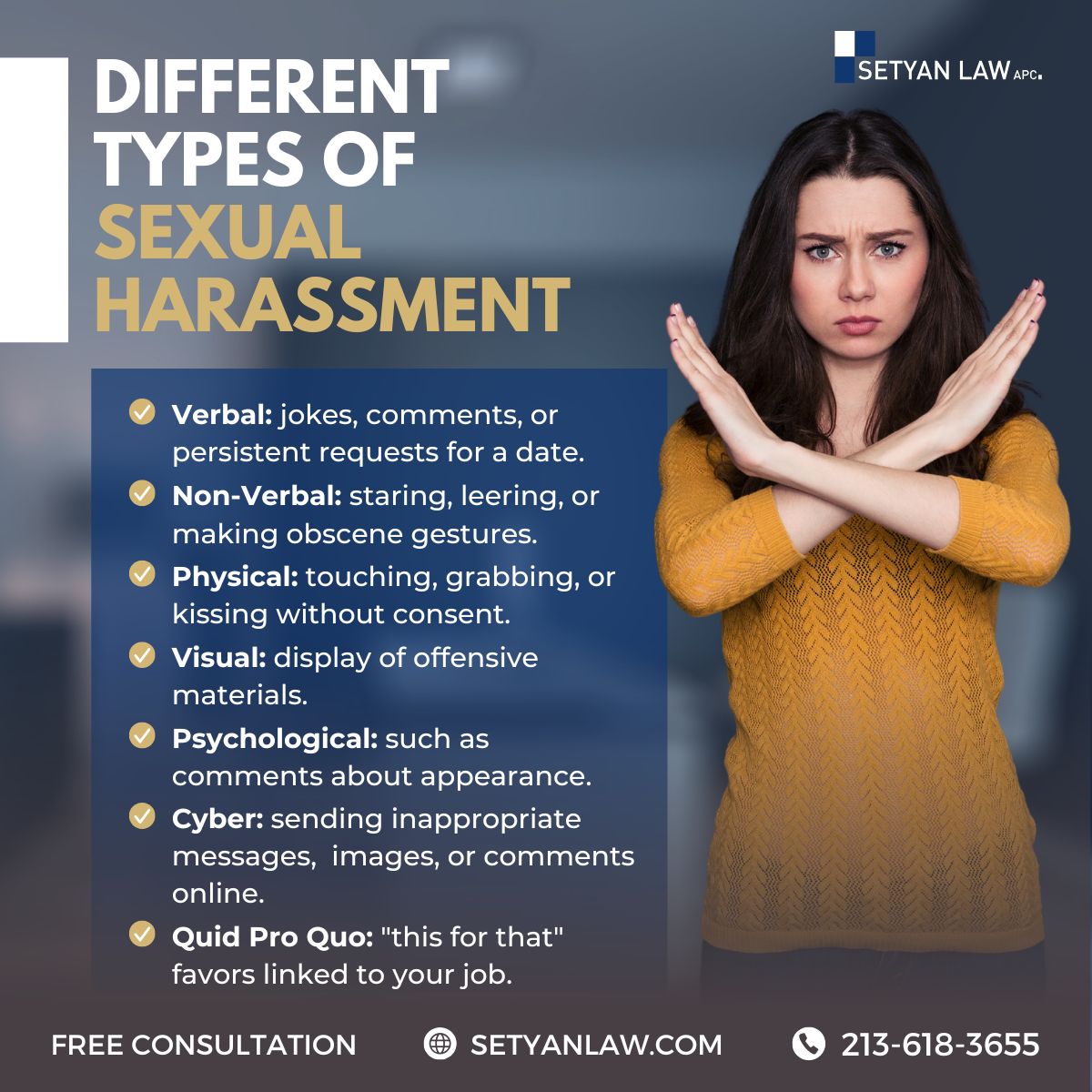Updated September 5, 2025
Are You Being Sexually Harassed at Work?
Sexual harassment is a form of discrimination that is not only illegal but also can cause significant harm to the victim. Unfortunately, sexual harassment is prevalent in many workplaces, and it can happen to anyone, regardless of gender, age, or position. It is essential to understand the different types of sexual harassment to identify and address them effectively. In this article, we will discuss the various forms of sexual harassment and how to recognize and take action against them.
Defining Sexual Harassment
Sexual harassment is an unwelcome sexual advance, request for sexual favors, or other verbal or physical conduct of a sexual nature that affects an individual’s employment or creates an intimidating, hostile, or offensive work environment. Sexual harassment can happen to anyone, regardless of their gender or sexual orientation. It can occur in any workplace, including schools, hospitals, restaurants, and even online.
Sexual harassment can take various forms, including verbal, non-verbal, physical, visual, psychological, cyber, and quid pro quo harassment. Understanding the different types of sexual harassment is essential to identify and address them effectively.
Understanding the Different Types of Sexual Harassment
Verbal Sexual Harassment
Verbal sexual harassment involves unwelcome verbal comments of a sexual nature that can be explicit or implicit. Examples of verbal sexual harassment include sexual jokes or comments, sexual propositions, sexual innuendos, or persistent requests for a date or sexual favors. Verbal sexual harassment can happen in person, over the phone, or via email.
Non-Verbal Sexual Harassment
Non-verbal sexual harassment involves unwelcome physical gestures or actions of a sexual nature. Examples of non-verbal sexual harassment include staring, leering, or making obscene gestures. Non-verbal sexual harassment can also include unwelcome touching or brushing against someone’s body.
Physical Sexual Harassment
Physical sexual harassment involves unwelcome physical contact of a sexual nature. Examples of physical sexual harassment include touching, grabbing, or kissing without consent. Physical sexual harassment can also include sexual assault or rape.
Visual Sexual Harassment
Visual sexual harassment involves the display of offensive materials, such as posters, pictures, or emails, that are sexually suggestive or explicit. Visual sexual harassment can also include the use of explicit gestures or facial expressions.
Psychological Sexual Harassment
Psychological sexual harassment involves the use of psychological tactics to intimidate, threaten, or manipulate someone in a sexual manner. Examples of psychological sexual harassment include threats of sexual assault, spreading rumors about someone’s sexual behavior, or making inappropriate comments about someone’s appearance.
Cyber Sexual Harassment
Cyber sexual harassment involves the use of digital technology to harass, intimidate, or threaten someone in a sexual manner. Examples of cyber sexual harassment include sending sexually explicit messages or images, spreading rumors about someone’s sexual behavior online, or posting sexually suggestive comments on someone’s social media accounts.
Quid Pro Quo Harassment
Quid pro quo harassment involves unwelcome sexual advances, requests for sexual favors, or other verbal or physical conduct of a sexual nature that is explicitly or implicitly linked to an employment decision. For example, a supervisor may offer a promotion or a pay raise in exchange for sexual favors.
How to Identify Sexual Harassment in the Workplace
Identifying sexual harassment in the workplace can be challenging since it can take many forms, and it may not always be evident. However, some signs can help you identify sexual harassment, such as:
- Unwelcome sexual advances
- Unwanted physical contact
- Sexual comments or jokes
- Display of offensive materials
- Sexual propositions or requests for sexual favors
- Threats of sexual assault or rape
- Intimidation or manipulation in a sexual manner
- Pressure to engage in sexual activity
If you experience any of these signs, you may be a victim of sexual harassment. It is essential to take action to protect yourself and prevent further harm.
What to Do if You Are Being Sexually Harassed at Work
If you are being sexually harassed at work, the first step is to tell the harasser to stop. If they do not stop, you can report the harassment to your supervisor, HR department, or a higher authority. It is essential to document the harassment by keeping a record of the incidents, including the date, time, and location, and the actions you took to address it.
If your employer does not take action to address the harassment or retaliates against you for reporting it, you may file a complaint with the Equal Employment Opportunity Commission (EEOC) or your state’s fair employment agency.
Examples of Sexual Harassment in the Workplace
Sexual harassment can take many forms, and it can happen to anyone, regardless of their position or gender. Some examples of sexual harassment in the workplace include:
- A supervisor making sexual comments or jokes to a subordinate
- A coworker sending sexually explicit emails to another coworker
- An employer displaying sexually suggestive materials in the workplace
- A manager pressuring an employee for sexual favors in exchange for a promotion
- A customer making unwanted sexual advances to an employee
Prevention and Addressing Sexual Harassment in the Workplace
Preventing and addressing sexual harassment in the workplace requires a comprehensive approach that involves educating employees, setting clear policies and procedures, and providing a safe and supportive environment.
Employers should have a zero-tolerance policy for sexual harassment and provide regular training to their employees to raise awareness about what constitutes sexual harassment and its consequences. They should also establish clear procedures for reporting and investigating sexual harassment claims and ensure that complaints are handled promptly and confidentially.
Employees who experience sexual harassment should feel safe to report it without fear of retaliation. Employers should provide support and resources to victims of sexual harassment, such as counseling or legal assistance.
Taking Action Against Sexual Harassment
Taking action against sexual harassment requires a collective effort from employers, employees, and society as a whole. Employers should ensure that their workplaces are free from sexual harassment and take prompt action to address any claims of sexual harassment. Employees should speak up and report any incidents of sexual harassment they experience or witness. Society should continue to raise awareness about sexual harassment and its harmful effects and work towards creating a culture that promotes respect and equality.
In conclusion, sexual harassment is a serious issue that can cause significant harm to the victim and the workplace as a whole. Understanding the different types of sexual harassment and how to recognize and address them is essential to prevent and address sexual harassment effectively. It is essential to take action to protect yourself and others from sexual harassment and promote a safe and respectful workplace for all.
California employment cases can be complex. Your employer will likely fight back. You need someone on your side to protect your rights and get the money you deserve.
Call Setyan Law at (213)-618-3655 for a consultation.






